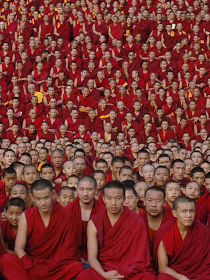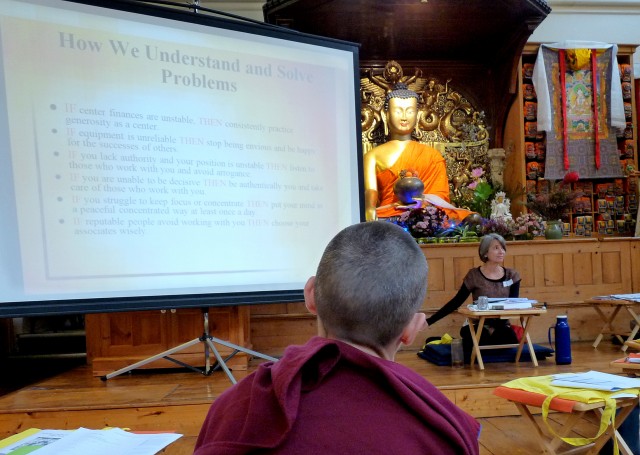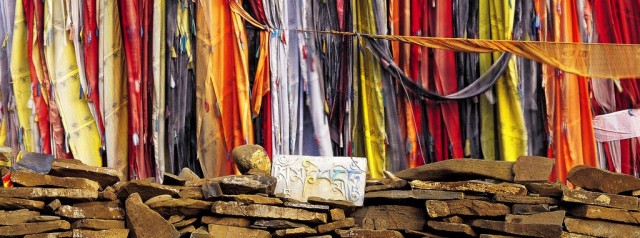- Home
- FPMT Homepage
Foundation for the Preservation of the Mahayana Tradition
The FPMT is an organization devoted to preserving and spreading Mahayana Buddhism worldwide by creating opportunities to listen, reflect, meditate, practice and actualize the unmistaken teachings of the Buddha and based on that experience spreading the Dharma to sentient beings. We provide integrated education through which people’s minds and hearts can be transformed into their highest potential for the benefit of others, inspired by an attitude of universal responsibility and service. We are committed to creating harmonious environments and helping all beings develop their full potential of infinite wisdom and compassion. Our organization is based on the Buddhist tradition of Lama Tsongkhapa of Tibet as taught to us by our founders Lama Thubten Yeshe and Lama Thubten Zopa Rinpoche.
- Willkommen
Die Stiftung zur Erhaltung der Mahayana Tradition (FPMT) ist eine Organisation, die sich weltweit für die Erhaltung und Verbreitung des Mahayana-Buddhismus einsetzt, indem sie Möglichkeiten schafft, den makellosen Lehren des Buddha zuzuhören, über sie zur reflektieren und zu meditieren und auf der Grundlage dieser Erfahrung das Dharma unter den Lebewesen zu verbreiten.
Wir bieten integrierte Schulungswege an, durch denen der Geist und das Herz der Menschen in ihr höchstes Potential verwandelt werden zum Wohl der anderen – inspiriert durch eine Haltung der universellen Verantwortung und dem Wunsch zu dienen. Wir haben uns verpflichtet, harmonische Umgebungen zu schaffen und allen Wesen zu helfen, ihr volles Potenzial unendlicher Weisheit und grenzenlosen Mitgefühls zu verwirklichen.
Unsere Organisation basiert auf der buddhistischen Tradition von Lama Tsongkhapa von Tibet, so wie sie uns von unseren Gründern Lama Thubten Yeshe und Lama Thubten Zopa Rinpoche gelehrt wird.
- Bienvenidos
La Fundación para la preservación de la tradición Mahayana (FPMT) es una organización que se dedica a preservar y difundir el budismo Mahayana en todo el mundo, creando oportunidades para escuchar, reflexionar, meditar, practicar y actualizar las enseñanzas inconfundibles de Buda y en base a esa experiencia difundir el Dharma a los seres.
Proporcionamos una educación integrada a través de la cual las mentes y los corazones de las personas se pueden transformar en su mayor potencial para el beneficio de los demás, inspirados por una actitud de responsabilidad y servicio universales. Estamos comprometidos a crear ambientes armoniosos y ayudar a todos los seres a desarrollar todo su potencial de infinita sabiduría y compasión.
Nuestra organización se basa en la tradición budista de Lama Tsongkhapa del Tíbet como nos lo enseñaron nuestros fundadores Lama Thubten Yeshe y Lama Zopa Rinpoche.
A continuación puede ver una lista de los centros y sus páginas web en su lengua preferida.
- Bienvenue
L’organisation de la FPMT a pour vocation la préservation et la diffusion du bouddhisme du mahayana dans le monde entier. Elle offre l’opportunité d’écouter, de réfléchir, de méditer, de pratiquer et de réaliser les enseignements excellents du Bouddha, pour ensuite transmettre le Dharma à tous les êtres. Nous proposons une formation intégrée grâce à laquelle le cœur et l’esprit de chacun peuvent accomplir leur potentiel le plus élevé pour le bien d’autrui, inspirés par le sens du service et une responsabilité universelle. Nous nous engageons à créer un environnement harmonieux et à aider tous les êtres à épanouir leur potentiel illimité de compassion et de sagesse. Notre organisation s’appuie sur la tradition guéloukpa de Lama Tsongkhapa du Tibet, telle qu’elle a été enseignée par nos fondateurs Lama Thoubtèn Yéshé et Lama Zopa Rinpoché.
Visitez le site de notre Editions Mahayana pour les traductions, conseils et nouvelles du Bureau international en français.
Voici une liste de centres et de leurs sites dans votre langue préférée
- Benvenuto
L’FPMT è un organizzazione il cui scopo è preservare e diffondere il Buddhismo Mahayana nel mondo, creando occasioni di ascolto, riflessione, meditazione e pratica dei perfetti insegnamenti del Buddha, al fine di attualizzare e diffondere il Dharma fra tutti gli esseri senzienti.
Offriamo un’educazione integrata, che può trasformare la mente e i cuori delle persone nel loro massimo potenziale, per il beneficio di tutti gli esseri, ispirati da un’attitudine di responsabilità universale e di servizio.
Il nostro obiettivo è quello di creare contesti armoniosi e aiutare tutti gli esseri a sviluppare in modo completo le proprie potenzialità di infinita saggezza e compassione.
La nostra organizzazione si basa sulla tradizione buddhista di Lama Tsongkhapa del Tibet, così come ci è stata insegnata dai nostri fondatori Lama Thubten Yeshe e Lama Zopa Rinpoche.
Di seguito potete trovare un elenco dei centri e dei loro siti nella lingua da voi prescelta.
- 欢迎 / 歡迎
简体中文
“护持大乘法脉基金会”( 英文简称:FPMT。全名:Foundation for the Preservation of the Mahayana Tradition) 是一个致力于护持和弘扬大乘佛法的国际佛教组织。我们提供听闻,思维,禅修,修行和实证佛陀无误教法的机会,以便让一切众生都能够享受佛法的指引和滋润。
我们全力创造和谐融洽的环境, 为人们提供解行并重的完整佛法教育,以便启发内在的环宇悲心及责任心,并开发内心所蕴藏的巨大潜能 — 无限的智慧与悲心 — 以便利益和服务一切有情。
FPMT的创办人是图腾耶喜喇嘛和喇嘛梭巴仁波切。我们所修习的是由两位上师所教导的,西藏喀巴大师的佛法传承。
繁體中文
護持大乘法脈基金會”( 英文簡稱:FPMT。全名:Found
ation for the Preservation of the Mahayana Tradition ) 是一個致力於護持和弘揚大乘佛法的國際佛教組織。我們提供聽聞, 思維,禪修,修行和實證佛陀無誤教法的機會,以便讓一切眾生都能 夠享受佛法的指引和滋潤。 我們全力創造和諧融洽的環境,
為人們提供解行並重的完整佛法教育,以便啟發內在的環宇悲心及責 任心,並開發內心所蘊藏的巨大潛能 — 無限的智慧與悲心 – – 以便利益和服務一切有情。 FPMT的創辦人是圖騰耶喜喇嘛和喇嘛梭巴仁波切。
我們所修習的是由兩位上師所教導的,西藏喀巴大師的佛法傳承。 察看道场信息:
- FPMT Homepage
- News/Media
-
- Study & Practice
-
-
- About FPMT Education Services
- Latest News
- Programs
- New to Buddhism?
- Buddhist Mind Science: Activating Your Potential
- Heart Advice for Death and Dying
- Discovering Buddhism
- Living in the Path
- Exploring Buddhism
- FPMT Basic Program
- FPMT Masters Program
- FPMT In-Depth Meditation Training
- Maitripa College
- Lotsawa Rinchen Zangpo Translator Program
- Universal Education for Compassion & Wisdom
- Online Learning Center
-
- Prayers & Practice Materials
- Overview of Prayers & Practices
- Full Catalogue of Prayers & Practice Materials
- Explore Popular Topics
- Benefiting Animals
- Chenrezig Resources
- Death & Dying Resources
- Lama Chopa (Guru Puja)
- Lama Zopa Rinpoche: Compendium of Precious Instructions
- Lama Zopa Rinpoche: Life Practice Advice
- Lama Zopa Rinpoche Practice Series
- Lamrim Resources
- Mantras
- Prayer Book Updates
- Purification Practices
- Sutras
- Thought Transformation (Lojong)
- Audio Materials
- Dharma Dates - Tibetan Calendar
- Translation Services
- Publishing Services
- Ways to Offer Support
- Prayers & Practice Materials
-
- Teachings and Advice
- Find Teachings and Advice
- Lama Zopa Rinpoche Advice Page
- Lama Zopa Rinpoche: Compendium of Precious Instructions
- Lama Zopa Rinpoche Video Teachings
- ༧སྐྱབས་རྗེ་བཟོད་པ་རིན་པོ་ཆེ་མཆོག་ནས་སྩལ་བའི་བཀའ་སློབ་བརྙན་འཕྲིན།
- Podcasts
- Lama Yeshe Wisdom Archive
- Buddhism FAQ
- Dharma for Young People
- Resources on Holy Objects
- Teachings and Advice
-
-
*If a menu item has a submenu clicking once will expand the menu clicking twice will open the page.
-
-
- Centers
-
- Teachers
-
- Projects
-
-
-
-
*If a menu item has a submenu clicking once will expand the menu clicking twice will open the page.
-
-
- FPMT
-
-
-
-
-
According to the Buddhist view, there is no human problem that cannot be solved by human beings.
Lama Thubten Yeshe
-
-
-
- Shop
-
-
-
The Foundation Store is FPMT’s online shop and features a vast selection of Buddhist study and practice materials written or recommended by our lineage gurus. These items include homestudy programs, prayers and practices in PDF or eBook format, materials for children, and other resources to support practitioners.
Items displayed in the shop are made available for Dharma practice and educational purposes, and never for the purpose of profiting from their sale. Please read FPMT Foundation Store Policy Regarding Dharma Items for more information.
-
-
Mandala
23
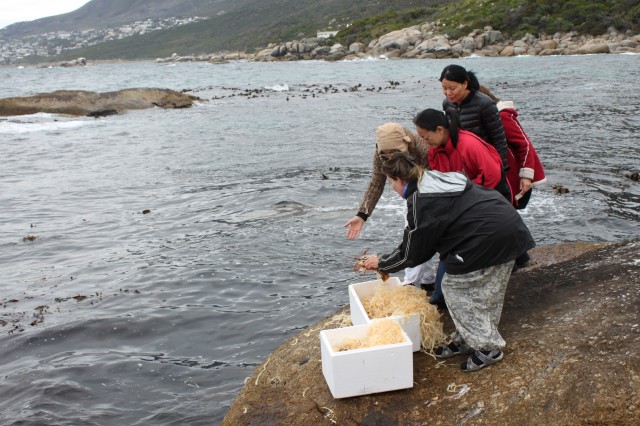
Tibetan Buddhist students in South Africa practicing animal liberation, September 2013. Photo courtesy of Nina McNaught.
A lone FPMT student in South Africa emailed Mandala about doing animal liberation practice for Lama Zopa Rinpoche. Nina McNaught reported that in September 2013 a small group of Tibetan Buddhists from different traditions in Cape Town gathered with a visiting Nyingma lama, Chamtrul Rinpoche, to release crayfish into the cold Atlantic Ocean.
“How wonderful it was to be able to release approximately 25 happy wriggling and perfectly blessed crayfish into our marine reserve, Oudekraal,” Nina wrote. “And how fortunate to be able to offer this practice to our most beloved guru Lama Zopa Rnpoche for his long, long life!”
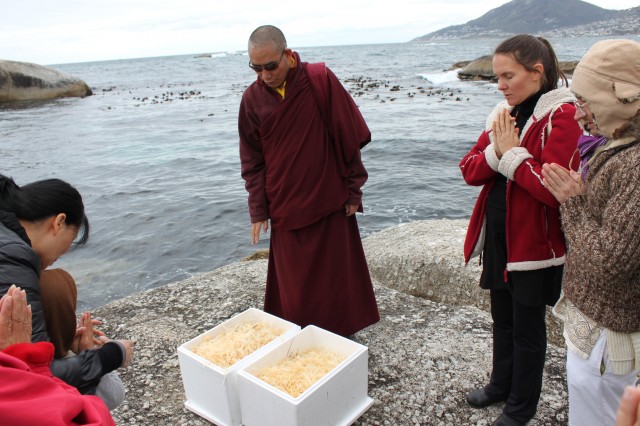
Chamtrul Rinpoche with Buddhist students in Cape Town, South Africa. Photo courtesy of Nina McNaught.
Mandala brings you news of Lama Zopa Rinpoche and of activities, teachings and events from over 160 FPMT centers, projects and services around the globe. If you like what you read on Mandala, consider becoming a Friend of FPMT, which supports our work.
- Tagged: animals, mandala, nina mcnaught, south africa
- 0
22
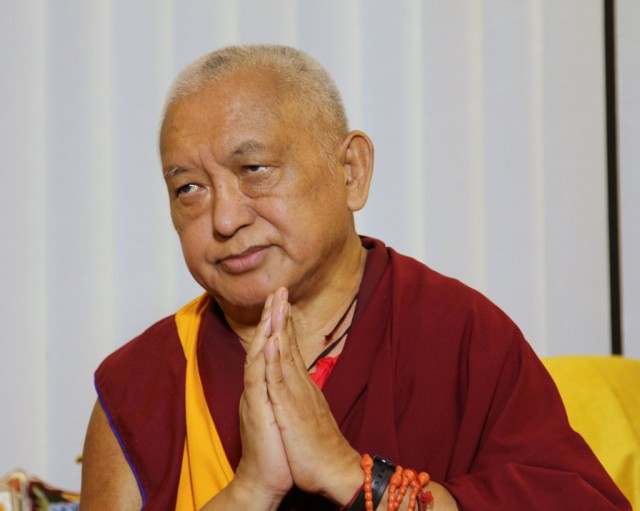
Rinpoche thanking benefactors for their very kind and generous donations to the Sera Je Food Fund, Sera Je Monastery, India, January 2014. Photo by Ven. Roger Kunsang.
The Sera Je Food Fund, which was started by Lama Zopa Rinpoche in 1991, currently offers more than 3 million meals each year to the monks of Sera Je Monastery, allowing the monks there to focus on their studies.
“I just want to explain some things about the Sera Je Food Fund, just for your education and also maybe you can pass some of this on,” Lama Zopa Rinpoche advised in 2011 while at Tushita Meditation Centre in Dharamsala, India. “[To paraphrase,] Buddha said in the Arya Sanghata Sutra: the result of making charity, even the size of a single strand of hair, is happiness that you will experience for 80,000 eons. You will enjoy great wealth. …
“This quote means if you make charity of anything, even just a tiny amount, the result of this is happiness for an unbelievable, unbelievable, unbelievable length of time. Just from making charity one time,” Rinpoche continued.
“Regarding the Sera Je Food Fund, this is making offerings to Sangha … wow … wow! Can you imagine the merit of that? Even making small charity the size of a single strand of hair? Can you imagine? In the monastery there are Sangha living in the five vows, but the majority of the Sangha are living in higher vows such as getsül (36 vows) and gelong, a fully ordained bhikkshu (253 vows). Most of the Sangha are gelongs and living in highest number of vows … wow … wow … wow! One creates so much merit by making offerings to Sangha due to the power of the object. …”
For more, you can read Rinpoche’s complete advice, “Benefits of the Sera Je Food Fund.”
Learn more about the Sera Je Food Fund, including its history, and watch videos of the fund’s work by visiting the Sera Je Food Fund website.
Lama Zopa Rinpoche is the spiritual director of the Foundation for the Preservation of Mahayana Tradition (FPMT), an organization dedicated to preserving Mahayana Buddhism through offering the Buddha’s authentic teachings and to facilitating reflection, meditation, practice and the opportunity to actualize and directly experience the Buddha’s teachings. Sign up to receive news and updates.
- Tagged: lama zopa rinpoche, mandala, sera je food fund
- 0
21
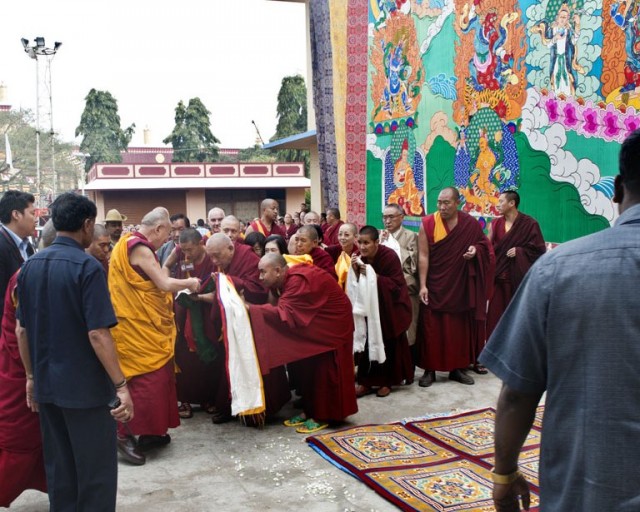
His Holiness the Dalai Lama with Lama Zopa Rinpoche and the giant Guru Rinpoche thangka, Sera Je Monastery, India, December 29, 2013. Photo copyright Rio Helmi/Jangchup Lamrim Teaching Organizing Committee.
The Lama Zopa Rinpoche Bodhichitta Fund, under the instruction of Lama Zopa Rinpoche, sponsored an enormous Guru Rinpoche (Padmasambhava) thangka stitched in appliqué. During the recent Jangchub Lamrim teachings at Sera Monastery, His Holiness the Dalai Lama blessed the thangka early one morning before the teachings.
Rinpoche advised on the design of the thangka, which with its brocade board measures 90-feet (27-meters) wide by 70-feet (23-meters) high. The thangka took two years to make and was completed in 2013. It is for the Guru Rinpoche Bum Tsog (100,000 tsog offerings) in Nepal.
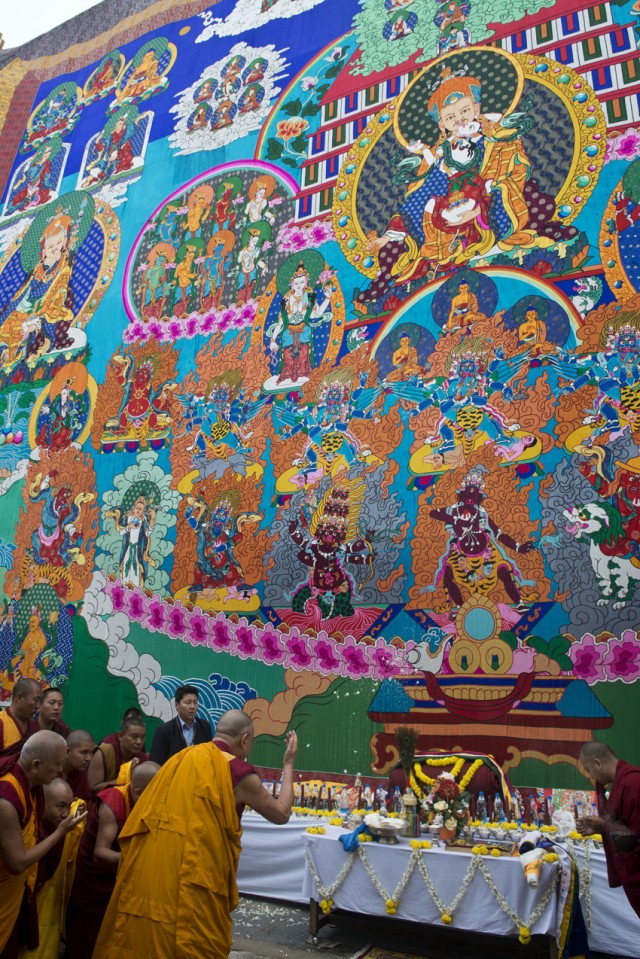
His Holiness the Dalai Lama blessing the thangka, Sera Monastery, India, December 29, 2013. Photo copyright Rio Helmi/Jangchup Lamrim Teaching Organizing Committee.
Mandala brings you news of Lama Zopa Rinpoche and of activities, teachings and events from over 160 FPMT centers, projects and services around the globe. If you like what you read on Mandala, consider becoming a Friend of FPMT, which supports our work.
- Tagged: his holiness the dalai lama, jangchup lamrim, lama zopa rinpoche, lama zopa rinpoche bodhichitta fund, mandala, padmasambhava, thangkas
- 0
17
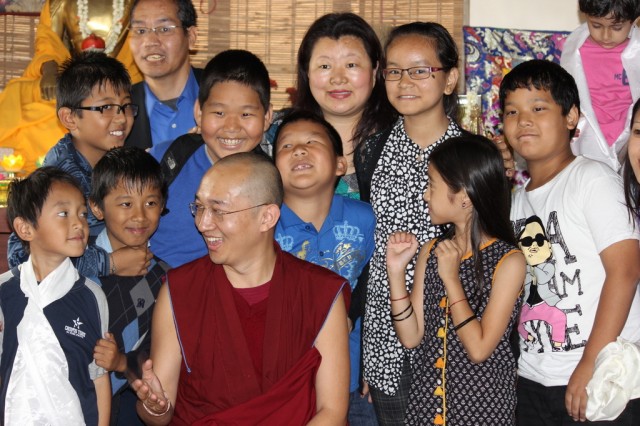
The 8th Khangser Rinpoche helped Choe Khor Sum Ling celebrate its 10th anniversary, Bangalore, India, November 2013. Photo courtesy of Choe Khor Sum Ling.
Choe Khor Sum Ling (CKSL) in Bangalore, India, celebrated its tenth anniversary on November 17, 2013. To celebrate, CKSL organized a special teaching event about transforming everyday experiences into sources of great joy. The teachings also addressed eliminating stress and obstacles; generating boundless joy by cultivating pure love towards others; focusing less on self; focusing more on benefiting others; and reducing expectations and abandoning the thoughts of results.
CKSL is an active study group offering regular instruction in meditation and Buddhist philosophy, including FPMT’s Discovering Buddhism program. International Mahayana Institute monks studying at Sera Monastery regularly give teachings to CKSL students, who are “a lively group of kind, open-minded Indians, Tibetans and foreigners, both young and old.”
Mandala brings you news of Lama Zopa Rinpoche and of activities, teachings and events from over 160 FPMT centers, projects and services around the globe. If you like what you read on Mandala, consider becoming a Friend of FPMT, which supports our work.
- Tagged: choe khor sum ling, khangser rinpoche, mandala
- 0
15
Burnout: Is It Really a Problem?
More than 40 people from 17 countries came together in late October for the FPMT Foundation Service Seminar, organized by FPMT Education Services and hosted by Jamyang Buddhist Centre London. The gathering drew together a wide array of dedicated FPMT staff for five full days of service learning sessions on skillfully offering service within the FPMT mandala. About 20 people stayed for an additional three days of sessions as part of a program to become qualified to facilitate the seminar in their home center, country or region. Sarah Brooks, spiritual program coordinator (SPC) at Kadampa Center in Raleigh, North Carolina, US, attended the seminar and shares some ideas and remedies for burnout that were discussed there for Mandala‘s January-March 2014 online content.
When we started discussing antidotes for burnout at the Foundation Service Seminar, Ven. Robina Courtin asked the group if this was really an issue for us. All around the room hands went up with voices chanting, “Yes!” There was wide agreement that we struggle with it in our service at our Dharma centers and projects, and see other volunteers and staff struggle as well.
As SPC at Kadampa Center in Raleigh, North Carolina, US, I had faced this exhausted feeling for months before the seminar, and was seeing eight days of training as a vacation – that’s how much I needed to get away for a while! Our center has experienced strong growth in attendance and programs, particularly over the past year (which is fantastic!), but our resources and staff are not growing as quickly. The result has been an undercurrent of burnout running throughout our staff and key volunteers, who were already overstretched.
From what I’ve seen and heard, this is common across the FPMT; we are inspired by Lama Zopa Rinpoche’s huge bodhichitta and never-give-up attitude, on top of which, the needs of sentient beings are countless. When my self-pity kicks in, I start wondering how I can possibly keep up. I have felt like I can never give or offer enough, yet out of dedication, I keep pushing to do more. At times I become overwhelmed, feeling like there’s no more to give. When am I going to sprout a thousand arms?! When I have felt as if I can’t possibly do one more thing on top of everything else, I have sometimes thought that maybe quitting would be the only way to feel sane again. …
From Mandala January-March 2014
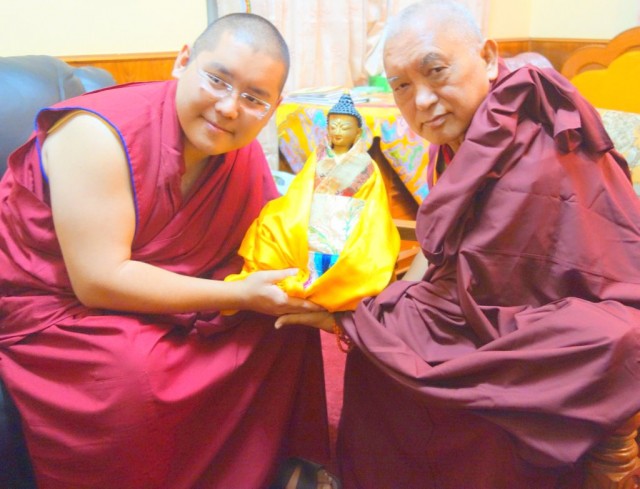
Ling Rinpoche and Lama Zopa Rinpoche, Sera Monastery, India, January 2014. Photo by Ven. Roger Kunsang.
The 2013 Jangchup Lamrim teachings by His Holiness the Dalai Lama successfully concluded on January 3 with His Holiness conferring the 1000-Armed Chenrezig initiation. His Eminence Ling Rinpoche is the main organizer of the Jangchup Lamrim teaching series.
“This year, His Holiness completed the commentary and oral transmission of several more of the 18 lam-rim texts, and he will continue teaching the remaining lam-rims in a location and on dates to be announced,” reported the Jangchup Lamrim website, which offers photos and videos of the teachings as well as news updates and quotations drawn from the 18 lam-rim commentaries that comprise the Jangchup Lamrim.
In order to make familiar to my own mind,
And to help benefit fortunate others as well,
I’ve explained here in words easy to understand
In its entirety the path that pleases the conquerors.
“Through this virtue may all beings be never divorced
From the perfectly pure excellent path” thus I pray;
I, a yogi, have made aspirations in this manner;
You, who aspire for liberation, too should pray likewise.
– From The Concise Treatise on the Stages of the Path to Enlightenment (also known as Song of the Stages of the Path) by Je Tsongkhapa. As translated in: Songs of Experience on the Stages of the Path by Je Tsongkhapa. Translated by Thubten Jinpa, PhD.
More information, photos and updates about FPMT spiritual director Lama Zopa Rinpoche can be found on Rinpoche’s homepage. If you’d like to receive news of Lama Zopa Rinpoche via email, sign up to Lama Zopa Rinpoche News.
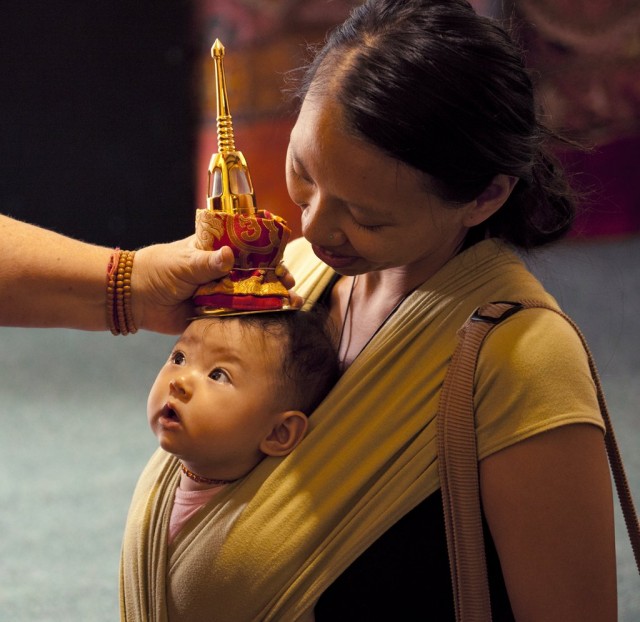
A mother and child receiving blessing from relics, Mullumbimby, Australia, 2012. Photo by Andy Melnic, courtesy of Maitreya Loving Kindness Tour.
The Maitreya Heart Shrine Relic Tour has a new name: the Maitreya Loving Kindness Tour. The tour brings the sacred relics of Buddhist masters to Buddhists and non-Buddhists around the world. Hundreds of thousands of people on six continents have viewed the relics, which started touring in March 2001.
In addition to a new name, the FPMT-affiliated project has a new Facebook page and has update their website with news photos from the tours as well as images and biographical information for the Buddhist masters whose relics are part of the tour. Tour dates and locations for the Americas tour and the tour of Europe, Asia and Australia can also be found on the project’s website.
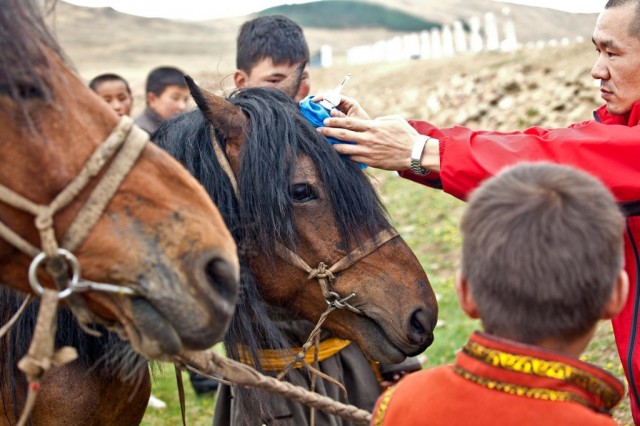
Roadside blessing with relics in Mongolia, 2012. Photo by Andy Melnic, courtesy of Maitreya Loving Kindness Tour.
For more, including tour schedule, photos, video and relic information, visit the Maitreya Loving Kindness Tour online.
Mandala brings you news of Lama Zopa Rinpoche and of activities, teachings and events from over 160 FPMT centers, projects and services around the globe. If you like what you read on Mandala, consider becoming a Friend of FPMT, which supports our work.
- Tagged: heart shrine relic tour, mandala
- 0
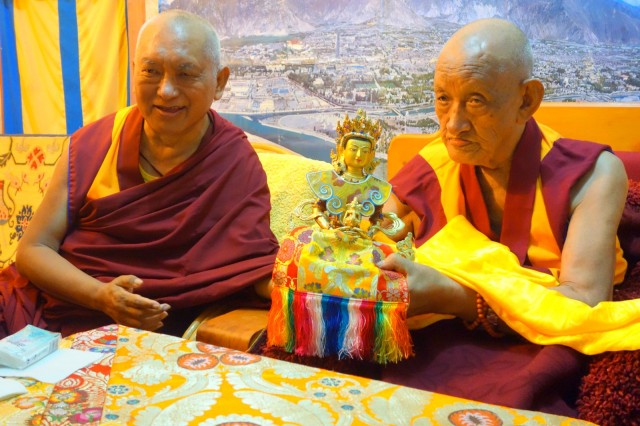
Lama Zopa Rinpoche with Khensur Rinpoche Losang Tsering, who is offering a long life statue to Rinpoche, Sera Monastery, India, December 2013. Photo by Ven. Roger Kunsang.
While at Sera Monastery in December 2013, Lama Zopa Rinpoche had dinner with Khensur Rinpoche Losang Tsering. Khensur Rinpoche offered a long life statue to Rinpoche and thanked him for all his kindness to the monks of Sera Je.
When Khensur Rinpoche was serving as abbot of Sera Je in 1990, he made a request to Lama Zopa Rinpoche to sponsor the food for Sera Je monks. It was a very practical request made to help all of the monks there at the time Lama Ösel entered the monastery. Khensur Rinpoche is now 91 years old and considered one of the great teachers at Sera Je. He counts many of the Kopan monks as his students.
More information, photos and updates about FPMT spiritual director Lama Zopa Rinpoche can be found on Rinpoche’s homepage. If you’d like to receive news of Lama Zopa Rinpoche via email, sign up to Lama Zopa Rinpoche News.
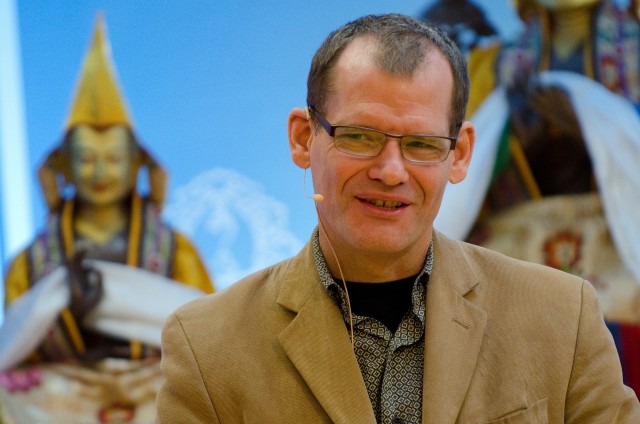
John Dunne, 2013 Maitripa College Buddhism & Science Symposium, Portland, Oregon, US, October 2013. Photo by Marc Sakamoto.
What do we think of when we hear the word mindfulness? Does it change depending on the context? How has the term been understood in the past? Is its popularity significant to Buddhism’s future? John Dunne, associate professor of religion at Emory University and a fellow of the Mind and Life Institute, has both the technical Buddhist philosophical background and connection to contemporary scientific research exploring mindfulness necessary to address these questions. During a visit in October 2013 to Maitripa College in Portland, Oregon, US, John spent a half-hour summing up for Mandala readers the many centuries of meaning that have collected around the word “mindfulness.” We share the complete interview as part of our January-March 2014 online content.
Mandala: I wanted to talk to you about the concept of mindfulness and how it has been articulated and used both historically and in contemporary settings. Within the FPMT, Lama Zopa Rinpoche has encouraged FPMT students to understand mindfulness within the Mahayana tradition. Could you talk about how mindfulness has been used in classical Indian Buddhist philosophy and then whether subsequently that evolved and changed within Tibetan Buddhism?
John Dunne: If we just think about the contemporary use of mindfulness, there is a lot of interest in mindfulness on many levels. You could say it has even become a kind of cultural trope in the United States. I heard it on the radio sometime when I was listening to NPR during a pledge drive. Someone was talking about “mindful pledging” – and this is in Atlanta! I was surprised to find that; you see that everywhere, in Europe and among the educated elites of the big cities worldwide as well. There is a lot of interest in mindfulness. It is a cultural meme that has taken off to an unbelievable degree. And maybe that’s part of the reason why it is also very hard to say what it is. It is in some way whatever you make of it, and there really are many different varieties of mindfulness.
One of the ways in which my scientific colleagues and I have been trying to understand it is therefore not in terms of finding a single version of what is the one true mindfulness, but rather to think of it as a family or range of practices and a range of practice styles that come out of different kinds of Buddhist contexts. That is actually a very useful way to think about it in Buddhist terms as well, because it is really not the case that there is just one version of mindfulness even within Buddhism, possibly ever. Certainly by the time Buddhism reaches Tibet, there is already some significant differentiation in how it would be proper to use that term. …
From Mandala January-March 2014
30
Lama Zopa Rinpoche on the Benefits of the Mani Retreat
The accomplishment of the 100 Million Mani Retreat in Mongolia in August 2013 is momentous for FPMT. The purpose of the retreat, in part, was to help reestablish Buddhism in Mongolia. But Rinpoche had articulated his vision for FPMT students to do mani retreats more than a decade ago. This wish led to the inaugural 100 million mani retreat in 2000 at Chenrezig Institute, in Queensland, Australia.
On November 26, 2000, FPMT students gathered at Chenrezig Institute to do the first 100 million mani retreat undertaken by FPMT in the West, which was scheduled to end on Losar (February 24, 2001). Rinpoche attended the retreat December 22-26, giving teachings and also observing the retreat to fine tune the schedule and practices.
Here’s a short excerpt from Teachings from the Mani Retreat. The excerpt is taken from the teachings given on December 22 and was reproduced as part of Mandala’s January-March 2014 online content.
“This is such a wonderful time, especially doing practice to develop compassion and bodhichitta. Without compassion you can’t have the realization of bodhichitta, you can’t enter the Mahayana path, you can’t achieve enlightenment, you can’t achieve the infinite qualities of the holy body, holy speech and holy mind of Buddha. Without great compassion you can’t do perfect work for sentient beings, bringing them to enlightenment. I mentioned this the other night when I arrived, but maybe it was difficult to hear so late at night. …
“We should especially think of death. When the thought of death comes, when we remember death, there’s nothing else that makes sense; everything else is total nonsense. When we think of death, so much of what we do in life doesn’t make sense; it’s all just nonsense. The only thing that makes sense is Dharma practice. Only Dharma will benefit us at the time of death and after death. The only thing that we can carry with us and can enjoy in our future life is Dharma – nothing else.
“This practice of the meditation-recitation of the Buddha of Compassion will especially benefit us. Reciting OM MANI PADME HUM has merit as limitless as the sky. Even Buddha can never finish explaining the unbelievable purification and collection of extensive merit brought by reciting OM MANI PADME HUM.”
From Mandala January-March 2014
30
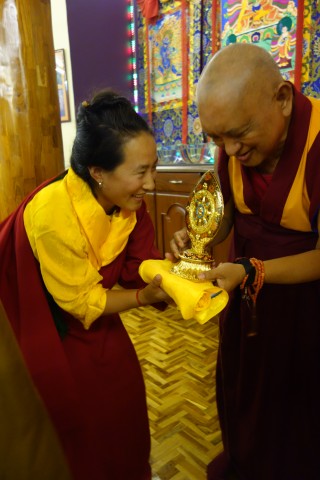
Khadro-la greeting Lama Zopa Rinpoche at Sera Monastery, India, December 2013. Photo by Ven. Roger Kunsang.
Lama Zopa Rinpoche and Khadro-la (Rangjung Neljorma Khadro Namsel Drönme) met for dinner recently while at Sera Monastery in South India.
Rinpoche and Khadro-la are attending the Jangchup Lamrim teachings by His Holiness the Dalai Lama at Sera Monastery. The teachings, which began on December 25 and continue through January 3, can be viewed on streaming video, available in six languages.
Many thousand monks from Sera are attending the teachings as well as monks and nuns from Kopan Monastery. In addition, many FPMT geshes, registered teachers, center directors and students from Asia, Australia, the Americas and Europe are also present.
Visit the Jangchup Lamrim website for more information and to view streaming video and photos of the event. More photos from the event and news are also available on His Holiness the Dalai Lama’s website, dalailama.com.
Lama Zopa Rinpoche is the spiritual director of the Foundation for the Preservation of Mahayana Tradition (FPMT), an organization dedicated to preserving Mahayana Buddhism through offering the Buddha’s authentic teachings and to facilitating reflection, meditation, practice and the opportunity to actualize and directly experience the Buddha’s teachings. Sign up to receive news and updates.
- Tagged: khandro kunga bhuma, lama zopa rinpoche, mandala
- 0
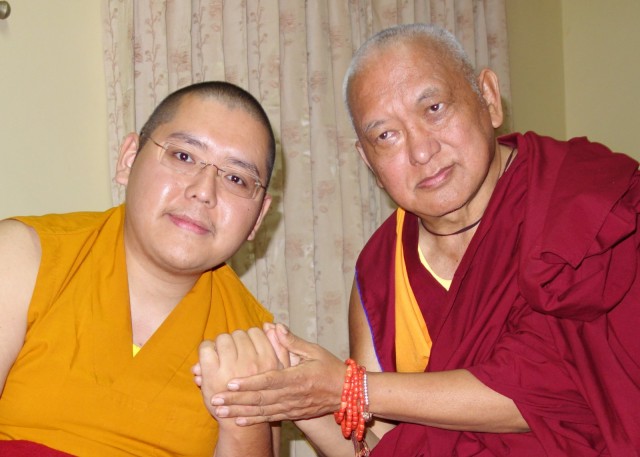
His Eminence Ling Rinpoche and Lama Zopa Rinpoche, Bylakuppe, India, December 2013. Photo by Ven. Roger Kunsang.
Lama Zopa Rinpoche visited with His Eminence Ling Rinpoche before the Jangchup Lamrim teachings by His Holiness the Dalai Lama at Sera Monastery. Ling Rinpoche is the main organizer of this lam-rim teachings series. The current round of teachings began on December 25, 3013, and runs through January 3, 2014.
Visit the Jangchup Lamrim website for more information and to view streaming video of the teachings.
Learn more about Lama Zopa Rinpoche, spiritual director of the Foundation for the Preservation of Mahayana Tradition (FPMT), and Rinpoche’s vision for a better world. Sign up to receive news and updates.
- Tagged: kyabje ling rinpoche, lama zopa rinpoche, mandala
- 0
- Home
- News/Media
- Study & Practice
- About FPMT Education Services
- Latest News
- Programs
- New to Buddhism?
- Buddhist Mind Science: Activating Your Potential
- Heart Advice for Death and Dying
- Discovering Buddhism
- Living in the Path
- Exploring Buddhism
- FPMT Basic Program
- FPMT Masters Program
- FPMT In-Depth Meditation Training
- Maitripa College
- Lotsawa Rinchen Zangpo Translator Program
- Universal Education for Compassion & Wisdom
- Online Learning Center
- Prayers & Practice Materials
- Overview of Prayers & Practices
- Full Catalogue of Prayers & Practice Materials
- Explore Popular Topics
- Benefiting Animals
- Chenrezig Resources
- Death & Dying Resources
- Lama Chopa (Guru Puja)
- Lama Zopa Rinpoche: Compendium of Precious Instructions
- Lama Zopa Rinpoche: Life Practice Advice
- Lama Zopa Rinpoche Practice Series
- Lamrim Resources
- Mantras
- Prayer Book Updates
- Purification Practices
- Sutras
- Thought Transformation (Lojong)
- Audio Materials
- Dharma Dates – Tibetan Calendar
- Translation Services
- Publishing Services
- Teachings and Advice
- Find Teachings and Advice
- Lama Zopa Rinpoche Advice Page
- Lama Zopa Rinpoche: Compendium of Precious Instructions
- Lama Zopa Rinpoche Video Teachings
- ༧སྐྱབས་རྗེ་བཟོད་པ་རིན་པོ་ཆེ་མཆོག་ནས་སྩལ་བའི་བཀའ་སློབ་བརྙན་འཕྲིན།
- Podcasts
- Lama Yeshe Wisdom Archive
- Buddhism FAQ
- Dharma for Young People
- Resources on Holy Objects
- Ways to Offer Support
- Centers
- Affiliates Area
- Teachers
- Projects
- Charitable Projects
- Make a Donation
- Applying for Grants
- News about Projects
- Other Projects within FPMT
- Support International Office
- Projects Photo Galleries
- Give Where Most Needed
- FPMT
- Shop
Subscribe to FPMT News
Translate*
*powered by Google TranslateTranslation of pages on fpmt.org is performed by Google Translate, a third party service which FPMT has no control over. The service provides automated computer translations that are only an approximation of the websites' original content. The translations should not be considered exact and only used as a rough guide.Superficial observation of the sense world might lead you to believe that people’s problems are different, but if you check more deeply, you will see that fundamentally, they are the same. What makes people’s problems appear unique is their different interpretation of their experiences.







